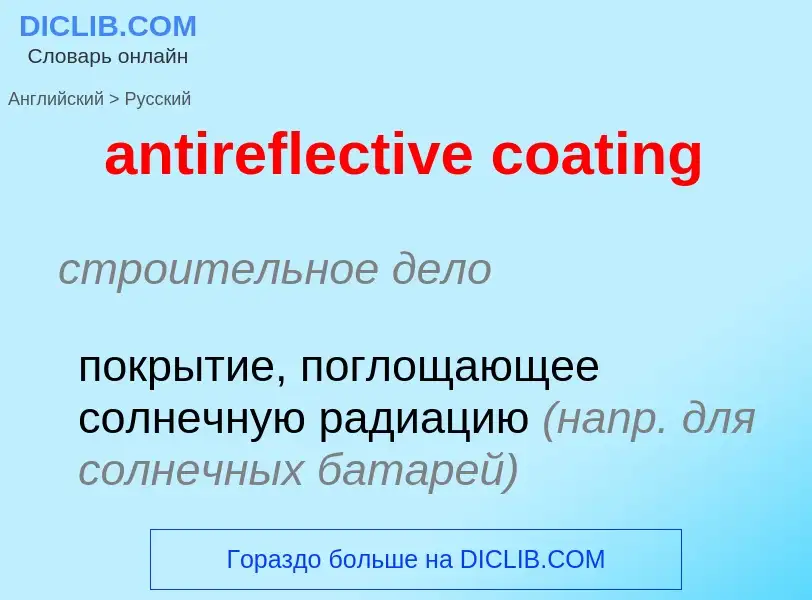Перевод и анализ слов искусственным интеллектом ChatGPT
На этой странице Вы можете получить подробный анализ слова или словосочетания, произведенный с помощью лучшей на сегодняшний день технологии искусственного интеллекта:
- как употребляется слово
- частота употребления
- используется оно чаще в устной или письменной речи
- варианты перевода слова
- примеры употребления (несколько фраз с переводом)
- этимология
antireflective coating - перевод на русский
строительное дело
покрытие, поглощающее солнечную радиацию (напр. для солнечных батарей)
[æntiri'flekʃ(ə)n]
общая лексика
просветление
прилагательное
радиотехника
антиотражающий
оптика
просветляющий
просветлённый
общая лексика
просветляющее покрытие
['kəutiŋ]
общая лексика
оболочка
покров
покрытие
нанесение покрытия
покрывающий слой
облицовка
грунтовка
грунт
шпаклёвка
полив (эмульсии)
обмазка
фотография
эмульсионная сторона (плёнки)
полиграфия
мелование (бумаги)
строительное дело
слой
нефтегазовая промышленность
обшивка (наружная)
существительное
общая лексика
слой (краски и т. п.)
покров
материал для пальто
одёжная ткань
слой (краски и т. п.)
шпаклевка, грунт
специальный термин
покрытие
обмазка
техника
обшивка
общая лексика
металлопокрытие
['kəutid]
общая лексика
покрытый
облицованный
нефтегазовая промышленность
обшитый (досками)
прилагательное
общая лексика
покрытый (чем-л.)
мелованный (о бумаге)
специальный термин
облицованный
Википедия

An antireflective, antiglare or anti-reflection (AR) coating is a type of optical coating applied to the surface of lenses, other optical elements, and photovoltaic cells to reduce reflection. In typical imaging systems, this improves the efficiency since less light is lost due to reflection. In complex systems such as cameras, binoculars, telescopes, and microscopes the reduction in reflections also improves the contrast of the image by elimination of stray light. This is especially important in planetary astronomy. In other applications, the primary benefit is the elimination of the reflection itself, such as a coating on eyeglass lenses that makes the eyes of the wearer more visible to others, or a coating to reduce the glint from a covert viewer's binoculars or telescopic sight.
Many coatings consist of transparent thin film structures with alternating layers of contrasting refractive index. Layer thicknesses are chosen to produce destructive interference in the beams reflected from the interfaces, and constructive interference in the corresponding transmitted beams. This makes the structure's performance change with wavelength and incident angle, so that color effects often appear at oblique angles. A wavelength range must be specified when designing or ordering such coatings, but good performance can often be achieved for a relatively wide range of frequencies: usually a choice of IR, visible, or UV is offered.







